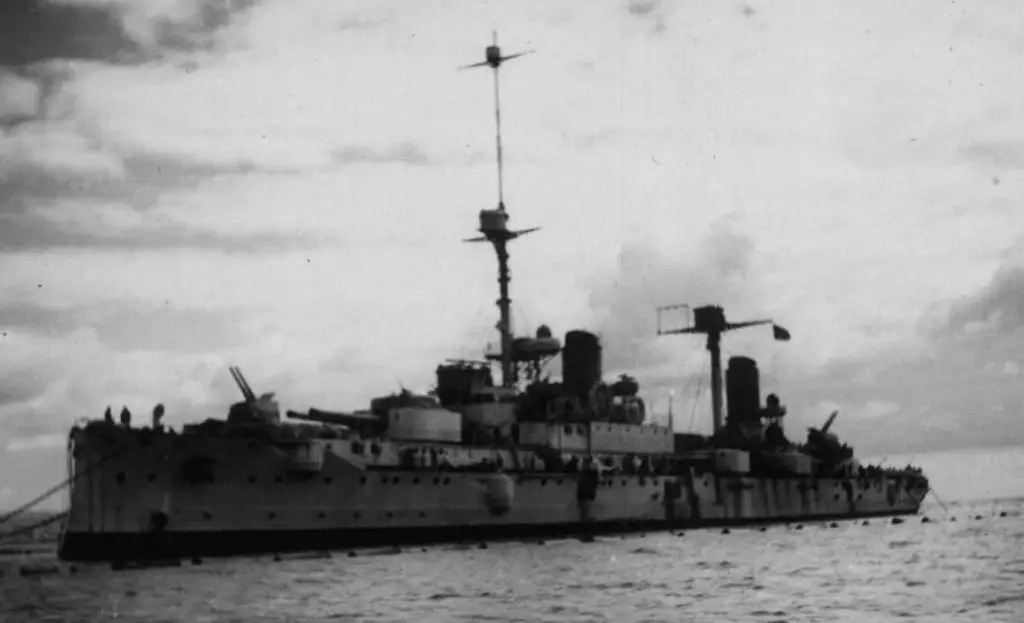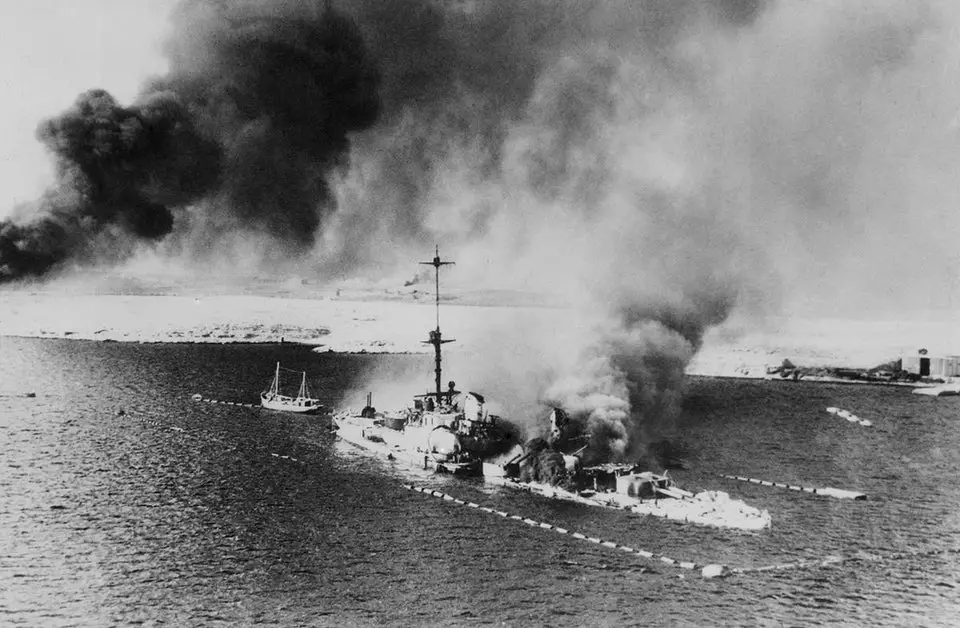Design
During the beginning of the 20th century, the Regia Marina started a new program of naval construction. It comprised, among others, a new class of two armored cruisers: the San Giorgio and San Marco. Displacing almost 11.000 tons, armed with 4×254 mm, 8x190mm and 18x76mm guns, the San Giorgio class cruiser resembled the classic armored cruiser layout. The only exceptions included that the San Marco utilized a steam turbine propulsion while the San Giorgio kept the classic vertical triple-expansion steam engine.
| Ship | Builder | Laid Down | Launched | Completed |
|---|---|---|---|---|
| San Giorgio | Regio Cantiere di Castellammare di Stabia | 4 July 1905 | 27 July 1908 | 7 February 1911 |
| San Marco | Regio Cantiere di Castellammare di Stabia | 1 September 1905 | 20 December 1908 | 1 July 1910 |
Following the project of Lieutenant General Edoardo Masdea, the ships were ordered in 1904 and laid down in 1905. As it was common for the Italian shipbuilding industry back then, the completion works lasted for quite some time, ending in 1910-1911. In the meantime, the advent of the dreadnought style battleship and the battlecruiser made these ships already obsolete by the time of their entry in service.
Italo-Turkish War
The San Marco successfully operated in the Italo-Turkish War of 1911-1912, in support of landing operations in Libya and the Dodecanese. It also took part in the bombardment of the Ottoman positions in the Dardanelles.
World War I
Both ships saw little action during the Great War. The submarine threat limited the operations of large ships, especially in the Adriatic Sea.
By the end of the war, this cruiser class was considered old. The two vessels became progressively relegated to secondary roles such as representation duties in the far east and recruit training.
Fate of San Marco

The San Marco
In 1931 the San Marco was disarmed and transformed into a radio-controlled target ship. Sized by the Germans in La Spezia in 1943 after Italy signed the armistice with the allies, it sunk in the harbor and scrapped after the Second World War.
Reconstruction of San Giorgio
Although being a very obsolete ship in the 1930s, the San Giorgio was luckier than its sister ship and found a new role after the time spent as a training ship. After a brief participation in the Spanish Civil War in support of the nationalist forces, the ship underwent a reconstruction process in 1937-1938.

A side view of San Giorgio.
The refit included the reduction of the boilers from 14 to 8 (with the remaining ones fitted for fuel and not coal), the removal of two funnels, the replacement of the 18x76mm guns with 4 twin turrets mounting the 100/47 dual-purpose guns. Several machine guns were added, and the three torpedo tubes removed since the new maximum speed of 18 knots was not really suitable for using such weapons.
World War Two
The cruiser once again as a training vessel for two years. However, at the outbreak of World War Two and the opening of the Mediterranean theatre, the Italian Navy High Command ordered the ship to Tobruk. There, it would have acted as a static defense platform for the naval base. Its job was to protect the harbor with the main armament and defend the skies with its new AA weapons.

The old cruiser in the port of Tobruk. Image: Archivio Centrale dello Stato.
Engagements
San Giorgio’s first engagement in the Second World War occurred on 12 June 1940. This was two days after Italy’s entry into the war. Two British light cruisers approached Tobruk but were repelled by the 254mm artilleries. On 19 June 1940, a British submarine tried to torpedo the old cruiser in port. The attack failed due to several anti-torpedo nets placed around the ship. In July 1940, RAF planes bombed Tobruk harbor, sinking the destroyers “Ostro” and “Zeffiro”, but the San Giorgio remained untouched.
Death of Italo Balbo

An infamous action involving the San Giorgio occurred on 28 June 1940, when 12 RAF Blenheim bombers attacked Tobruk. The cruiser immediately opened fire against the enemy planes. Shortly after the attack, two new planes appeared on the scene flying in direction of the Harbor. The San Giorgio opened fired once again and shot down the first plane.
This apparent success turned into tragedy after discovering the plane was an Italian SM.79 carrying Air Marshal Italo Balbo, Governor of Libya. For a long time, Mussolini was suspected of orchestrating the death of Italo Balbo, who many considered to be his chief rival. However, as more evidence became known, Balbo’s death was ultimately a result of an unfortunate accident.
Operation Compass
In late 1940 the situation in North Africa rapidly deteriorated for the Italian Army. After entering Egyptian territory and halting at Sidi el Barrani, the British counteroffensive in December (Operation Compass) pushed the Italians back. The Italian retreat became a rout. By January 1941 the British forces approached Tobruk. On 16 January 1941, the cruiser began opening fire against the British forward units on the outskirts of the city. The fire was ineffective due to poor visibility and the absence of observers on location.
On 20 January 1941, it was clear that the city would fall soon. The old armored cruiser could do nothing to stop the advance. Admiral Vietina (Navy commander of Tobruk) telegraphed the Supermarina in Roma, asking what should be done about the San Giorgio. Supermarina left the final decision to Marshal Graziani, who ordered the San Giorgio to make a final stand in the defense of Tobruk and fire its remaining ammunition.
Order to Scuttle
On the morning of 21 January 1941, the San Giorgio fired its last 254mm and 190mm salvos against British columns entering the city. By now, communications with the ground forces defending the city ceased. In the late afternoon, Lieutenant Burattini went ashore to assess the situation. Burattini received a message from Admiral Vietina saying that the city was lost. San Giorgio must be scuttled by the next morning.
Fate of San Giorgio

The San Giorgio in flames after being scuttled on 22 January 1941.
At 04:15 on 22 January 1941, the ammunition magazines (mined by the crew) exploded, enveloping the San Giorgio with flames and smoke. As a result, some crew members managed to escape the harbor on a fishing vessel and reached Italy a few days later.
In 1951 following World War II, Italy negotiated a deal with the Libyan authorities to purchase the wreck and bring it back home to a scrapyard. The ship was towed but during the crossing, the towing cables fell apart in rough seas. The San Giorgio sunk into depths of the Mediterranean, escaping the scrapyard forever.
Specifications
| Class | San Giorgio |
|---|---|
| Type | Armored Cruiser |
| Built | 1905-1911 |
| Displacement | 10796 tons |
| Length | 462 ft (140.89 m) |
| Beam | 69 ft (21.03 m) |
| Propulsion | 23,000 shp (San Marco), 19,500 shp (San Giorgio)
2 steam turbines (San Marco) 2 vertical triple expansion steam engines (San Giorgio) |
| Speed | 23 knots |
| Range | 4800 nm (at 10 knots) |
| Crew | 705 |
| Armament |
2 twin 254 mm (10.0 in)/45 guns twin 190 mm (7.5 in)/45 guns 18 single 76 mm (3.0 in)/40 guns 2 single 47 mm (1.9 in)/50 guns 3 × 450 mm (17.7 in) torpedo tubes |
| Armor | Belt: 200 mm (7.9 in) Gun turrets: 160–200 mm (6.3–7.9 in) Deck: 50 mm (2.0 in) Conning tower: 254 mm (10.0 in) |
Sources:
Franco Gay, Il San Giorgio a Tobruk, Storia Militare n.63 (dec 1998).